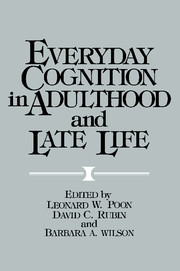Book contents
- Frontmatter
- Contents
- List of contributors
- Preface
- Part I Adult cognitive abilities in the laboratory and in real-life settings: Basic theoretical and methodological issues
- Part IA Systematic approaches to laboratory and real-world research
- Part IB Combining laboratory and real-world research
- Part II Cognition in adulthood and late life: Findings in real-life settings
- Part IIA Everyday cognitive abilities
- 11 Memory for prose: Perspectives on the reader
- 12 Prose processing in adulthood: The text, the reader, and the task
- 13 Speech comprehension and memory through adulthood: The roles of time and strategy
- 14 The effects of aging on perceived and generated memories
- 15 Aging and word retrieval: Naturalistic, clinical, and laboratory data
- 16 Acquisition and utilization of spatial information by elderly adults: Implications for day-to-day situations
- 17 Inner-city decay? Age changes in structure and process in recall of familiar topographical information
- 18 The cognitive ecology of problem solving
- 19 Everyday problem solving: Methodological issues, research findings, and a model
- 20 Prospective/intentional memory and aging: Memory as adaptive action
- Part IIB Concomitant influences
- Part III Cognitive enhancement and aging: Clinical and educational applications
- Part IIIA Issues and perspectives
- Part IIIB Enhancement approaches
- Part IIIC Designing programs for cognitive rehabilitation
- Subject index
- Author index
20 - Prospective/intentional memory and aging: Memory as adaptive action
Published online by Cambridge University Press: 05 October 2013
- Frontmatter
- Contents
- List of contributors
- Preface
- Part I Adult cognitive abilities in the laboratory and in real-life settings: Basic theoretical and methodological issues
- Part IA Systematic approaches to laboratory and real-world research
- Part IB Combining laboratory and real-world research
- Part II Cognition in adulthood and late life: Findings in real-life settings
- Part IIA Everyday cognitive abilities
- 11 Memory for prose: Perspectives on the reader
- 12 Prose processing in adulthood: The text, the reader, and the task
- 13 Speech comprehension and memory through adulthood: The roles of time and strategy
- 14 The effects of aging on perceived and generated memories
- 15 Aging and word retrieval: Naturalistic, clinical, and laboratory data
- 16 Acquisition and utilization of spatial information by elderly adults: Implications for day-to-day situations
- 17 Inner-city decay? Age changes in structure and process in recall of familiar topographical information
- 18 The cognitive ecology of problem solving
- 19 Everyday problem solving: Methodological issues, research findings, and a model
- 20 Prospective/intentional memory and aging: Memory as adaptive action
- Part IIB Concomitant influences
- Part III Cognitive enhancement and aging: Clinical and educational applications
- Part IIIA Issues and perspectives
- Part IIIB Enhancement approaches
- Part IIIC Designing programs for cognitive rehabilitation
- Subject index
- Author index
Summary
Something very complex and at the same time very common happened to all the authors of the chapters in this book. All of them managed to arrive at the Talland memorial conference. A number of things could have stood in the way of that arrival, and if they had, the participants would never have convened to produce these chapters. One of those things is a sort of memory. To get the flavor of this sort of memory, imagine that you are going on a trip. Think for a moment about some of the many memory-related things you need to do to accomplish that. You need to remember to plan your trip, or to get someone to do that. You need to prepare your house and spouse and children and cats and office for your departure. You need to remember to wash your socks and to bring those clean socks in a wellpacked suitcase. And you need to remember when and how to return home again.
As you scan, for a moment, what you would need to remember, you may notice that much of it falls into two categories: things you remember to do (“memory for planned action”), and things you remember because you need them in order to do the things you plan to do. An example of the former is “get on the plane”; an example of the latter is “remember the way to the airport.”
Information
- Type
- Chapter
- Information
- Everyday Cognition in Adulthood and Late Life , pp. 352 - 370Publisher: Cambridge University PressPrint publication year: 1989
Accessibility standard: Unknown
- 9
- Cited by
